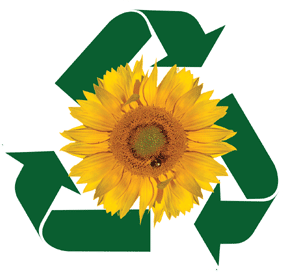Where Does the Trash Go?
 I am pleased to head up a “Green Team” at our office. The company I work for, Microgrid Solar, recently moved into a new and much larger office space, so I now have a private office that rivals the home office I’ve been so comfortable in the last few years. Working everyday with a great team is fun, and I’m honored at the chance to provide some leadership on our sustainability initiatives.
I am pleased to head up a “Green Team” at our office. The company I work for, Microgrid Solar, recently moved into a new and much larger office space, so I now have a private office that rivals the home office I’ve been so comfortable in the last few years. Working everyday with a great team is fun, and I’m honored at the chance to provide some leadership on our sustainability initiatives.
One of our policies is to divert at least 90% of our waste in the office and at job sites, so in the office kitchen, we often have to decide where the trash goes – recycling or landfill? Given the variety of standards, food packaging is one of the more challenging items to determine whether it goes in the recycling bin or the trash. We are fortunate to have access to a variety of restaurants in Clayton, and we often run out to pick up food and bring it back to eat at the office. I’m pleased to see more restaurants using recycled and recyclable materials in their packaging, including paper, plastic and foil. We have single-stream recycling (which means you can throw all recyclables into a single container), but it’s still far from simple when it comes to proper disposal. Since different waste haulers have different standards, it’s important to check with yours to find out what they’ll accept in the recycling bin.
The three Rs – Reduce-Reuse-Recycle – are consistently in that order for a reason. A good way to reduce is to bring your own reusable cloth or insulated bag to carry your lunch in, much like taking reusable bags to the grocery store. Or save yesterday’s bag and reuse it today or tomorrow rather than recycling it after a single use. If this seems a bit far-fetched, consider the millions of bags that are disposed of on a daily basis, and how they clog up not only our waste stream, but our waterways as well. Sure, the paper bags will break down, but the plastic bags are with us for hundreds of years.
Ideally, plastic flatware is for those people who have no other options. In our office, we have reusable plastic utensils, which we plan to upgrade to regular silverware, complemented by reusable plates and glassware. These can all be washed in bulk in an Energy Star dishwasher to minimize water and energy use. If you’re really progressive, you can have several volunteers take turns laundering cloth napkins and hand/dish towels on a regular basis.
While paper bags are clearly recyclable, the other waste, like paper towels, napkins and soiled containers fall into a grey area. Most waste haulers will not recycle “contaminated” items, like facial tissues and paper napkins soiled with grease or food. Pizza boxes, for example, are made of recyclable cardboard, but are often rejected because of the food stains. It is notable, however, that Washington University’s single-stream recycling program will accept just about anything except food, ice, liquids, and Styrofoam. Their waste hauler, IESI, will sort out anything that needs redirecting.
Many organizations are considering composting food waste as a next step in recycling. To simplify the process, Blue Skies Recycling offers a turnkey service to pick up organic food and plant matter in addition to single stream recyclables. This is particularly useful for restaurants and cafeterias, which generate tons of food waste on a regular basis. The food waste is picked up in special yellow containers, which are emptied, sanitized and returned for the next round of food waste.
Composting can also be done on a smaller scale in your home or office with volunteers. The truth is, just about anything organic can be composted, including paper products like napkins and paper towels. (The Learning Channel offered a list of 75 Things You Can Compost, But Thought You Couldn’t that I found very interesting.) There are a variety of solutions, depending on what type of space you have to maintain a compost bin. Most concerns about the smell of rotting food are unfounded – a properly maintained compost bin does not emit foul stenches as commonly assumed. More frequent watering and turning of the compost will accelerate the process, but even a neglected bin will produce rich, healthy fertilizer that will work wonders for a flower or vegetable garden. If you don’t have one, you can likely find a willing recipient! Earth911.com is a great resource for finding the right composting solution.
So, in your kitchen at home and at work, use three bins – one for recycling, one for composting, and one for the landfill. Hopefully, the landfill bin will end up being the smallest!
This was published in the Going Green section of the February 2013 issue of Spirit Seeker magazine.

